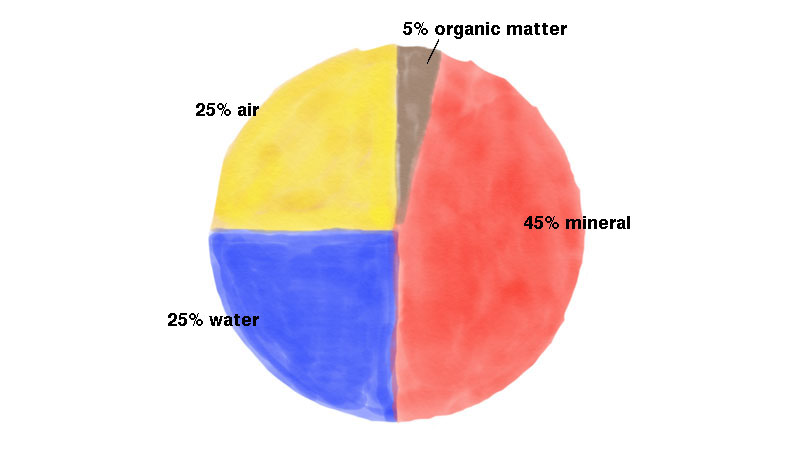
In order to understand what will make your permaculture garden successful, you need to understand what healthy soil is. And so, in the second installment of our two-part look at soil, we’re going to get down and dirty with a deep dive.
The same elements that make up Earth’s physical environments are found within every handful of soil as micro environments for life in the soil.
Soil is a mix of lithosphere, atmosphere, hydrosphere and the microbiosphere it sustains. Organic matter—those decomposing remains of the plants and animals—are the greatest byproduct of the biosphere for the growth of an edible ecosystem.
Organic matter is the building block of soil. And soil holds all of life’s weight in the balance.
As natural ecosystems evolve and succession occurs, a major player in this change is the increase in soil organic matter, accumulation and cycling.
Soil Formation
So how do we make this precious organic matter?
The leaves, twigs and stems of plants, as well as detritus and excrements from animals, decompose into humus.
A quality, healthy soil takes a lot of time to build from raw rocks or sand or clay. How long depends on climate, moisture, heat and biological factors in the ecosystem where soil-formation happens. Little by little, as plants set roots and animals move around, soil is created.
Read about methods for building healthy soil in your growing beds.
Raising the Bar on Soil Integrity
Building a raised bed and mixing compost into your local soil greatly improves the soil of your new planting site.
Soil compaction is one of the biggest factors in plant health. For a plant to be able to take up water and nutrients, there first has to be water and nutrients stored in the soil below.
Soil that is compacted has significantly reduced pore space. These spaces are responsible for holding and releasing nutrients and water to plants above.
When you raise you garden bed, you greatly reduce compaction. With an elevated planting surface, adjacent foot traffic doesn’t compact the bed’s interior.
Furthermore, by adding compost to your soil, you provide a key ingredient to help the soil’s aggregates stick together.
Soil aggregates are the building blocks of soil. They are essentially a mixture of soil particles (sand and silt) that are bound together by organic matter and clay particles to create stable voids in the soil.
These chunks of solid and void, mineral particles, organic matter and pore space, filled with water or air, is what we call an aggregate.
The Secret Ingredient, Soil Life
Cutting-edge research continuously reveals more on the importance of the soil life ecosystem for food plant health.
Certain bacteria, in association with leguminous plants, fix nitrogen right out of the atmosphere. Mycorrhizal fungi create relationships with plants and help them access water and nutrients in exchange for sugars made through plant photosynthesis.
All soil organisms participate in the essential soil-forming process of tunneling new pore space, shredding and digesting leaves, twigs and other debris into soil organic matter, and excreting the most potent nutrient source: micro manure. The ecosystem above contributes to the ecosystem below, and vice versa.
To define the major components of soil, therefore, we must adjust that classic pie chart to include the life within healthy soil. However, soil life can’t fit tidily into a segment of the pie.
We are talking about a growing, moving and evolving network of thousands of microorganism species and millions of individual creatures. As such, we can simply draw a life spiral within the pie chart to show the interdependent nature of the soil life ecosystem within our soils.
Growing Future Soil
Soil is important, yet we have increasingly degraded soil through urbanization, covering suburban yards with sod and pursuing monoculture agriculture. Compaction, pollution and erosion are huge problems.
Urbanization is rapidly compacting soils through infrastructure construction. This includes the soils in greenspaces that surround new building. Compacted urban soils cannot hold water, and they increase stormwater flow to rivers, causing flooding and pollution downstream.
Ecosystem landscaping aerates the soil, contributes organic matter, stabilizes against erosion and provides habitat for soil life to enhance all of these services further.
Healthy soil is great at storing carbon, which mitigates climate change. If we transitioned farms and lawns to healthy ecosystems that support soil functions, we could reverse climate change through the following:
- increase carbon sinks
- reduce emissions from land-use management
- create higher productivity across many socio-economic sectors
Are you planting trees the right way? Click to learn more.
Trees Are Terrific
Trees offer many more goods and services than meet the eye. One of their primary benefits is the formation and conservation of soil.
Tree roots and shoots hold soil in place, preventing it from washing away. Their leaves decompose to build more soil, while organic matter in the soil binds aggregates together for stability.
Soil is a precious resource to be conserved and regenerated. But it’s wasting away. Let’s regenerate it.




